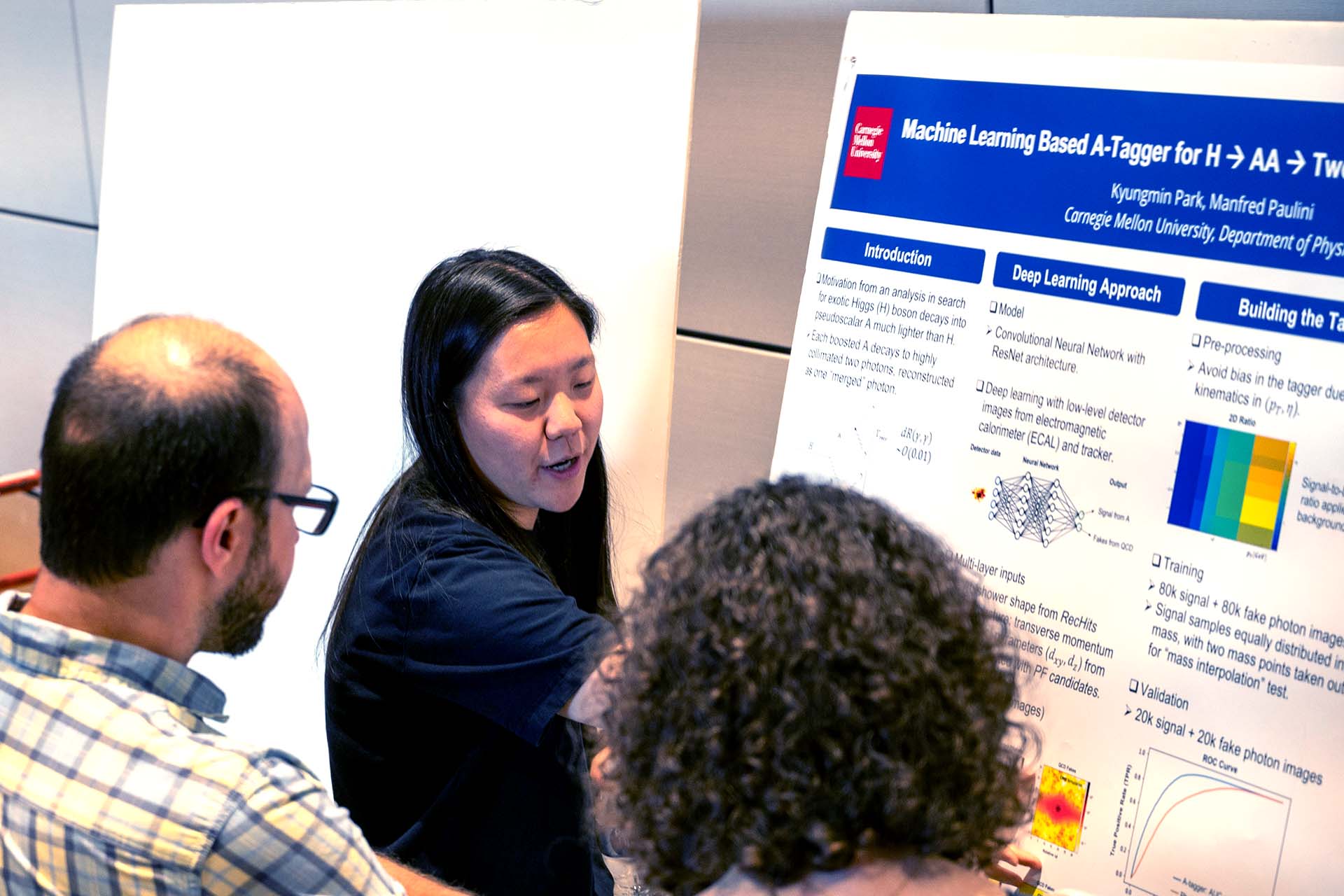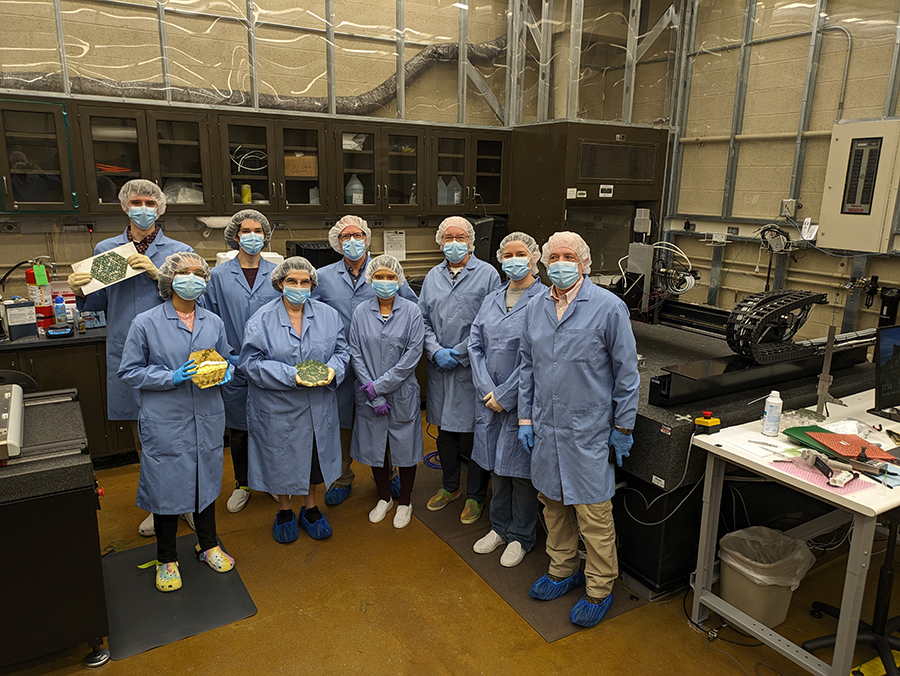U.S. CMS Collaborators Receive Approval for Massive Detector Upgrade
By Sarah Charley
Media Inquiries- Fermi National Accelerator Laboratory
- Interim Director of Communications, MCS
- 412-268-9982
The U.S. Department of Energy has formally approved the start of full production for the $200 million DOE-funded contributions to the upgrade of the CMS experiment at CERN. Together with contributions from other international partners, the upgrade will significantly improve the capabilities of the CMS detector and enable scientists to explore uncharted territory on the particle physics landscape.
“We want to understand what nature is telling us,” said Patty McBride, the CMS spokesperson and a distinguished scientist at DOE’s Fermi National Accelerator Laboratory. McBride is a 1977 physics graduate of Carnegie Mellon University and a 2019 Alumni Award winner. “These upgrades will allow us to extract more information from our detector and unlock more about the world and universe.”
CMS is an international collaboration of scientists who study the fundamental properties of matter using the CMS detector at CERN, an international physics laboratory on the Franco-Swiss border. More than 1,800 researchers from U.S. institutions work on the experiment.
Among those researchers are Carnegie Mellon Physics Professor Manfred Paulini, along with Assistant Professors John Alison, Matteo Cremonesi and Valentina Dutta, who organized the 2023 U.S. CMS Meeting at Carnegie Mellon’s campus in Pittsburgh.
Over the next three years, Alison, Dutta, Paulini and others will build and test 5,000 20-centimeter hexagonal electronics modules at Carnegie Mellon's module assembly center that will be used for a High-Granularity Calorimeter (HGC) upgrade to the CMS detectors. The upgrade will enhance the quality of the recorded data as well as cope with large amounts of ionizing radiation.
“I feel honored having been part of the team that worked the past 5 years toward this important approval milestone,” said Paulini, the Mellon College of Science associate dean for research who brought the project to Carnegie Mellon. “It will allow us at CMU to focus on starting up module production which also will offer opportunities for graduate and especially undergraduate students to obtain hands-on instrumentation experience working in our lab.”
“We’re not just replacing old pieces; we are pushing the envelope. The HL-LHC is going to be a proving ground for new detector technology.” — Steve Nahn
Physicists use the CMS detector to collect data from high-energy particle collisions produced by the Large Hadron Collider, the world’s biggest particle accelerator. At the end of the decade, the scientific reach of the LHC will become even more impressive thanks to the high-luminosity upgrade to the machine, which will begin in 2026. The recently released recommendations by the U.S. Particle Physics Project Prioritization Panel, known as the 2023 P5 report, lists the completion of the HL-LHC as a top priority for the U.S. particle physics community.
The upgrade will increase the collision rate by a factor of five, giving scientists a massive dataset to look for new particles and study rare subatomic processes. To keep up with the more intense particle beams, the CMS experiment needs a massive overhaul.
“We need new functionalities to cope with the harsh HL-LHC environment,” said Fermilab scientist Steve Nahn, the project manager for the U.S.-funded CMS upgrade. The project also receives funding from the U.S. National Science Foundation and is part of the international CMS upgrade plan.
Between 2029 and 2042, CMS scientists plan to collect 10 times more data than recorded since the startup of the LHC in 2010. Among many scientific goals, the additional data will enable scientists to develop a deeper understanding of the Higgs boson and how the Higgs field influenced the development and acted as dispersant of matter in the early universe.
“It’s not just looking at what’s unexpected; it’s also about having a deeper understanding of the particles we already know about, especially the Higgs,” McBride said.

Kyungmin Park, a doctoral student in Carnegie Mellon’s Department of Physics, explains her research at the 2023 meeting of U.S. CMS collaborators at Carnegie Mellon.
The rapid increase in data poses many challenges. The experiment will go from seeing about 60 proton-proton collisions every time the LHC beams cross to around 200. This jump in collision rate means that scientists not only need more bandwidth on their electronics, but new components that will help them get the most out of this surge in data. For example, a new timing detector will tag particles emerging from the collisions with an accuracy of around 30 picoseconds, giving scientists the ability to better determine the trajectory of the particles and gain a better understanding of how the particles interacted with each other.
“We’re not just replacing old pieces; we are pushing the envelope,” Nahn said. “The HL-LHC is going to be a proving ground for new detector technology.”
The U.S.-funded work will be carried out by scientists, engineers and technicians from Fermilab and 45 universities located in 23 states. Much of the work will be done by students, who make up a sizable fraction of the experiment.
At Carnegie Mellon, graduate and undergraduate students will help build the detector modules on the eighth floor of Wean Hall. Starting later this year and continuing until 2026, Carnegie University will begin the production phase building 12 modules daily and sending them to Fermilab for further assembly into larger components.
“This is a huge opportunity for students,” said Robin Erbacher, a professor at the University of California, Davis, and the chair of the U.S. CMS collaboration board. “We don’t build detectors every day.”
The worldwide CMS collaboration — which comprises 6,000 scientists from 57 countries — has been planning detector upgrades since the early 2000s. In 2016, the U.S.-funded CMS institutions, which make up about one-third of the collaboration, started the approval process with the US funding agencies for their planned contributions.
“This has been in the works for a long time,” Erbacher said.
During the approval process for the upgrade project, experts reviewed the physics goals, technical design reports, construction schedules and cost for the proposed detector components. The DOE approval, known as Critical Decision 3 and announced on January 11, allows the U.S.-funded CMS collaborators to move into full production on the proposed upgrades.
U.S. CMS collaborators will complete and ship their contributions to CERN between 2026 and 2027. The start-up of the high-luminosity LHC is foreseen for 2029.
